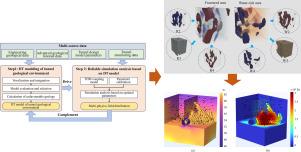基于隧道地质环境数字孪生模型的高温涌水危害可靠模拟分析
IF 7.4
1区 工程技术
Q1 CONSTRUCTION & BUILDING TECHNOLOGY
引用次数: 0
摘要
在复杂的山区地形中,隧道施工面临着高温水涌入危险的独特挑战,这是应力场、渗流场和温度场相互作用产生的系统风险。传统的模拟方法侧重于孤立的灾害场景,由于地质模糊和数据不完整,无法应对这些风险的多面性。数字孪生技术是应对这些挑战的有效解决方案,但其核心挑战在于如何在数据不完整的情况下,利用数字孪生技术对耦合的多物理场进行数据-模型-协同驱动的模拟分析。本文介绍了一种用于水涌模拟分析的数字孪生范例,该范例通过整合先进的机器学习和有限元分析技术,显著提高了效率和精度。具体来说,这是通过将基于高斯过程(GP)的高精度地质建模方法与通过高斯过程-微分演化(GP-DE)反向分析的参数校准方法相结合来实现的。首先,利用体素结构整合隧道环境的多场属性特征。其次,通过整合多源高级地质预测数据,利用机器学习技术构建隧道环境的动态数字孪生模型。为了克服建模精度低的问题,我们采用了 GP,加强了对多源地球物理数据中潜在信息的利用。最后,我们利用 GP-DE 反向分析方法来校准隧道环境参数,从而提高涌水模拟的精度和可靠性。该方法已通过应用于中国一个埋深 230 米的超高温涌水隧道段进行了验证。隧道的监测数据证实了该方法的准确性,为施工期间的动态优化设计和安全预防措施提供了支持。本文章由计算机程序翻译,如有差异,请以英文原文为准。

Reliable simulation analysis for high-temperature inrush water hazard based on the digital twin model of tunnel geological environment
In complex mountainous terrains, tunnel construction faces unique challenges from high-temperature water inrush hazards, a systemic risk arising from the interplay of stress, seepage, and temperature fields. Traditional simulation methods, focusing on isolated disaster scenarios, fall short in addressing the multifaceted nature of these risks due to geological ambiguity and data incompleteness. Digital twin technology presents an effective solution to these challenges; however, its core challenge lies in how to utilize digital twin technology for data-model-co-driven simulation analysis of coupled multi-physical fields in situations of incomplete data. This paper introduces a digital twin paradigm for the simulation analysis of water inrush, which significantly enhances efficiency and accuracy through the integration of advanced machine learning and finite element analysis techniques. Specifically, this is achieved by combining a high-precision geological modeling method based on Gaussian Processes (GP) with a parameter calibration method through Gaussian Process-Differential Evolution (GP-DE) back-analysis. Firstly, a voxel structure is utilized to integrate the multi-field attribute features of the tunnel environment. Secondly, through the integration of multi-source advanced geological prediction data, we construct a dynamic digital twin model of the tunnel environment leveraging machine learning techniques. To overcome the issue of low modeling accuracy, the GP is employed, enhancing the exploitation of latent information within multi-source geophysical data. Lastly, we utilize the GP-DE back-analysis method to calibrate the parameters of the tunnel environment, thereby enhancing the precision and reliability of water inrush simulations. The method has been validated through application to a section of an ultra-high-temperature water inrush tunnel in China, featuring a burial depth of 230 meters. The accuracy of the method is corroborated by the monitoring data from the tunnel, supporting dynamic optimization design and safety prevention measures during construction.
求助全文
通过发布文献求助,成功后即可免费获取论文全文。
去求助
来源期刊

Tunnelling and Underground Space Technology
工程技术-工程:土木
CiteScore
11.90
自引率
18.80%
发文量
454
审稿时长
10.8 months
期刊介绍:
Tunnelling and Underground Space Technology is an international journal which publishes authoritative articles encompassing the development of innovative uses of underground space and the results of high quality research into improved, more cost-effective techniques for the planning, geo-investigation, design, construction, operation and maintenance of underground and earth-sheltered structures. The journal provides an effective vehicle for the improved worldwide exchange of information on developments in underground technology - and the experience gained from its use - and is strongly committed to publishing papers on the interdisciplinary aspects of creating, planning, and regulating underground space.
 求助内容:
求助内容: 应助结果提醒方式:
应助结果提醒方式:


